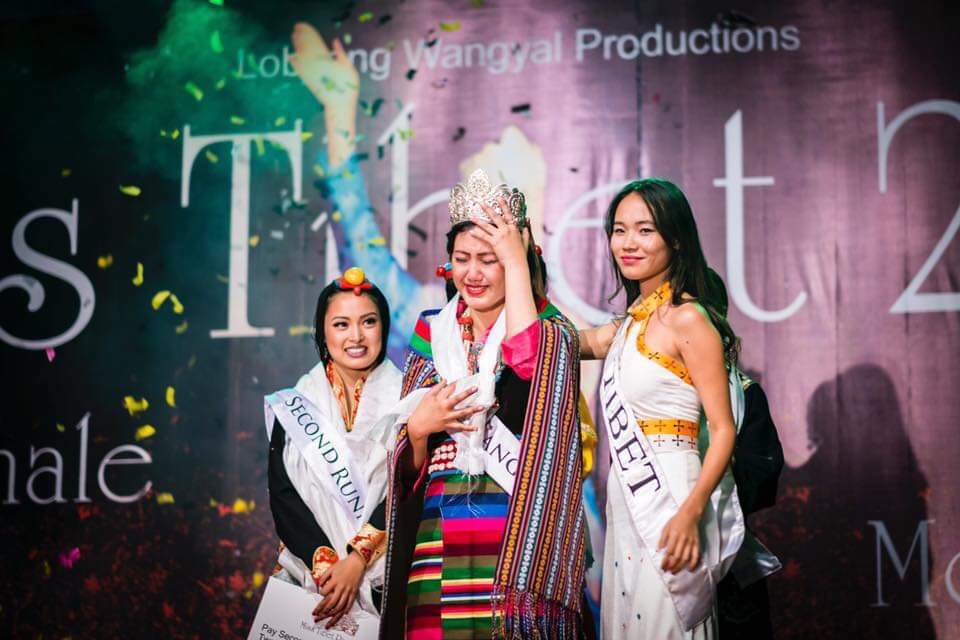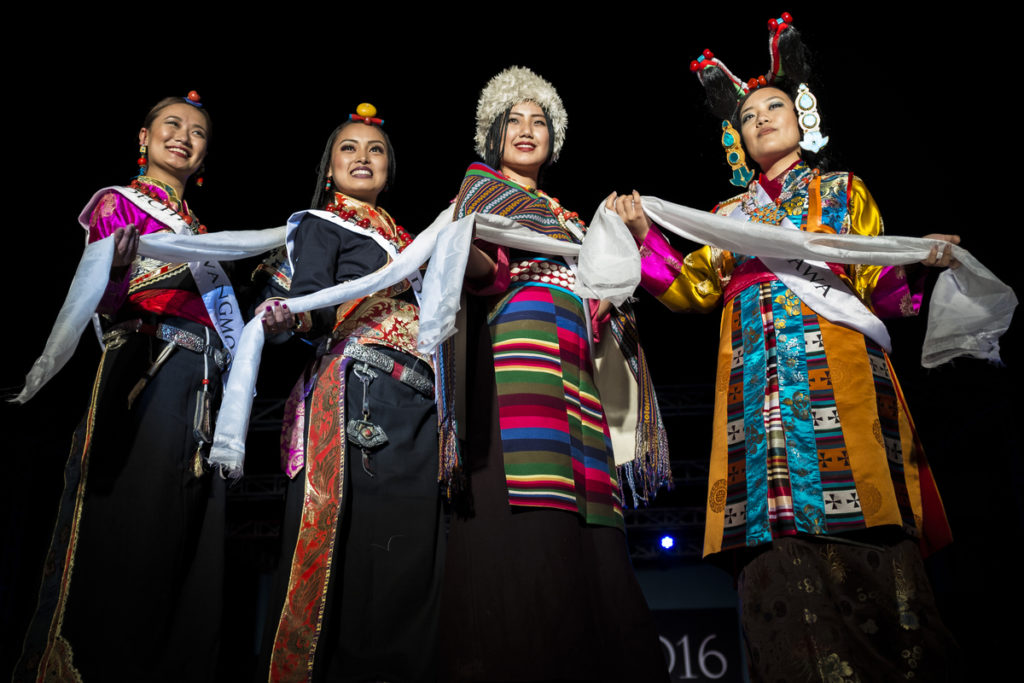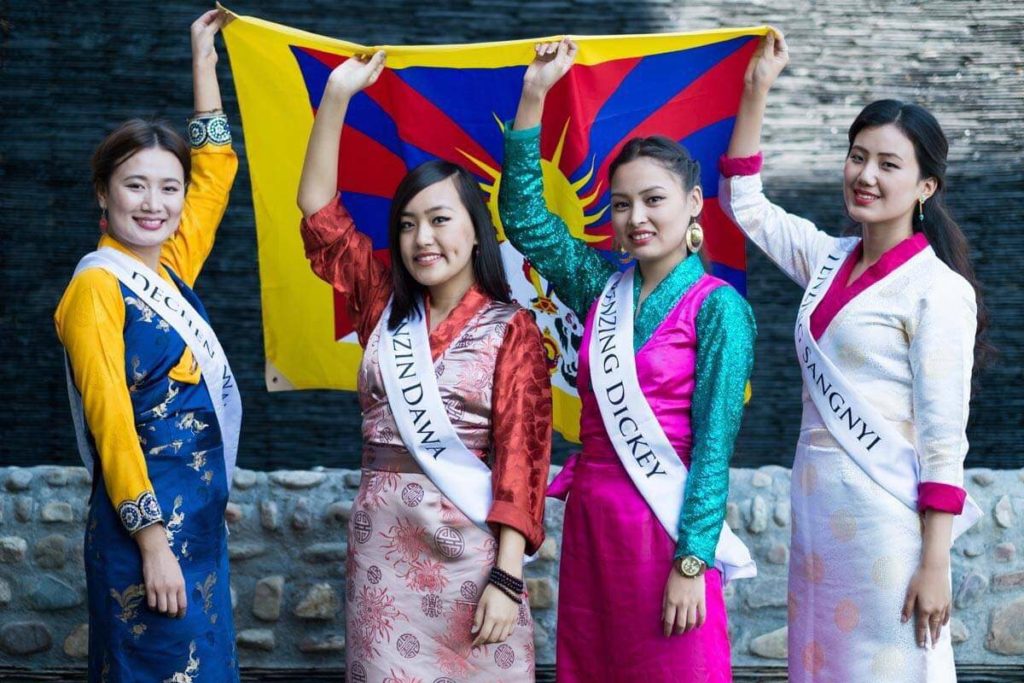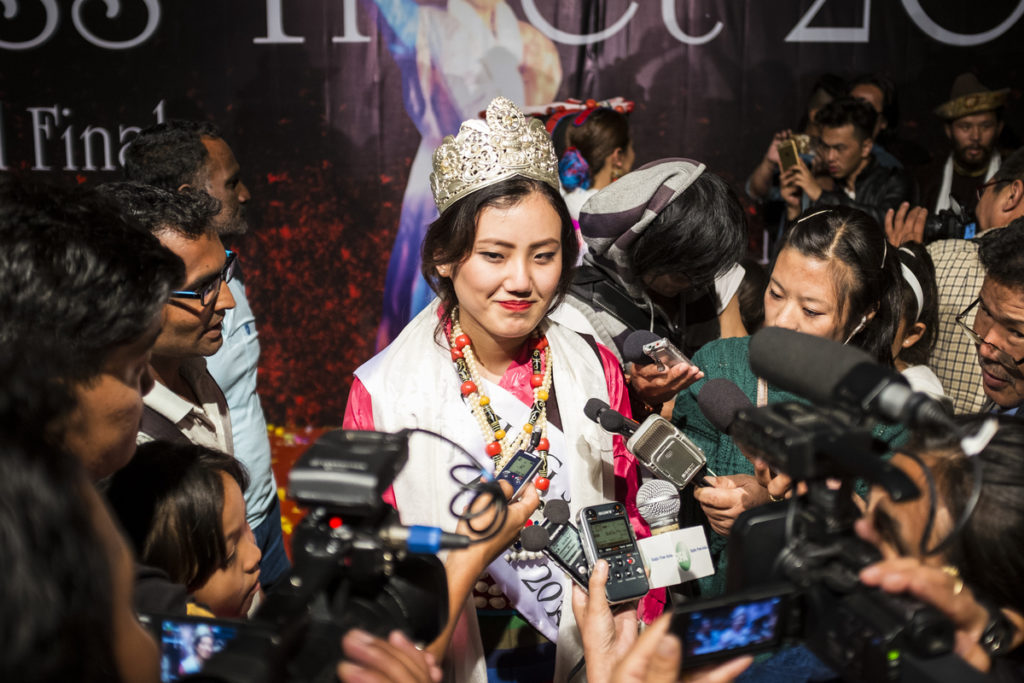
All photography courtesy of the Miss Tibet beauty pageant
How the Miss Tibet beauty pageant turned into a radical rite of passage
For writer Pema Monaghan, competing in the Miss Tibet beauty pageant is turning into a family tradition that represents freedom and expression – despite feminist criticisms.
Pema Monaghan
03 Sep 2020
I have two cousins who have been crowned Miss Tibet. This might seem like an inordinately high rate of beauty-queen family members, but Miss Tibet is actually a very underpopulated beauty pageant – so much so that in 2019, it was cancelled due to lack of applicants.
Tenzing Sangnyi was the second cousin of mine to have entered the competition. I watched a video of her being crowned Miss Tibet 2016. She’s wearing an ornate headdress that I don’t have a name for, a Tibetan apron, a heavy shawl, and a lot of jewellery. Her hair is in the traditional micro-braids sometimes worn by Tibetan women. She looks colourful. She looks nervous. When Lobsang Wangyal, the director of the competition, calls her name, she starts to cry and hug her fellow contestants. Miss Tibet 2015 keeps trying to put the crown on Tenzing Sangyi’s head, but she’s too busy hugging her friends to notice. I ask her how she felt after winning. “Rewarded for my hard work,” she says.
The Miss Tibet beauty pageant frames itself as radical and political. It asks for Tibetan culture to be seen as “living, breathing, [and] changing”, and identifies three barriers to this aim: Tibetan traditionalists, Western exoticising and the Chinese government.
Tibetan women from all over the world are permitted to enter the competition, but both of my cousins grew up in Himachal Pradesh, India. The competition itself takes place in McLeod Ganj, Dharamshala, India, where the Tibetan government-in-exile sits, and many Tibetans still live. Dharamshala sits along the Dhauladhar range of the Himalayas. My mother was born there. She grew up in a room covered in beautiful, thick rugs. Pink, blue, orange, black, different sizes and shapes, they cushioned each surface: warm; safe; home. Outside were open drains and romantic jungle.
People often ask me if I’ve been to Tibet. They’ve heard vaguely of the Chinese Communist Party (CCP) occupation in the past, but they don’t understand that Tibetans-in-exile don’t ever go back. In 1950, the CCP occupied Tibet and declared that it was a state of China. Since the occupation, acts of Tibetan nationhood have been surveilled and persecuted by the party. Tibet as a physical place is still heavily militarised, only accessible to tourists via CCP-sponsored tours. A 2010 Human Rights Watch report on China’s security forces in Tibet declared that peaceful critics of the regime had been subject to “disappearances, wrongful convictions and imprisonment”.

Some Tibetans still live in Tibet, but much of the population left during the invasion to seek refuge in other countries across the world. I grew up in Australia, eating momos (Tibetan dumplings), aloo gobi, and apricot chicken (an Australian delicacy involving French onion soup from a packet). Diaspora is one word for it – there is no nation state of Tibet, no way for young Tibetans to safely visit their grandparents’ homeland. Culture is therefore hard to hold on to, and hard to progress.
When my cousin Tenzin Choezom entered the pageant in 2009, my mother phoned me up from Canada to tell me. She said that it was brave of her to enter – not just because she would have to perform and to show her body in front of crowds, but because she might be putting herself in physical danger.
“My mother said my cousin was brave to enter the pageant because she might be putting herself in physical danger”
Beauty pageants, for Westerners (as my Tibetan mother called us), can be viewed as dangerous, I suppose, from an ideological standpoint. Miss Tibet has its feminist critics from within the diaspora; an online publication called the Tibetan Feminist Collective (run, as of 2016, by four women in New York) has published several articles about the competition. They are critical for the same reasons that I feel critical of Australian beauty pageants – there’s a focus on the body, a flattening of personhood.
The pageant’s entry criteria are telling: contestants must be “between 17 and 25 years of age”, “a minimum of 165cm in height”, and “unmarried and… not have given birth to a child”. Despite the given emphasis on independence, a contestant’s physicality is still of essential importance. Miss Tibet states that these criteria are given to qualify winners for international competitions; however comparable pageants, like Miss Great Britain and Miss USA, do not have such strict entry requirements around contestants’ bodies. The implication is that the women “representing Tibet” must be tall, and must appear available.

This feminist reading of the competition is not what my mother meant when she said “danger”. She was more concerned about physical threats. In a statement about the lack of 2019 applicants to Miss Tibet posted on the competition website, the pageant suggests that alleged threats from the Chinese government might be a reason for lessening interest. “The Chinese government has over the years interfered and pressured various international directors to ban Miss Tibet from their pageants. They demand that for a Miss Tibet to be in an international pageant, she should be sashed ‘Miss Tibet-China’.”
I ask Tenzing Sangnyi if she felt worried for her physical safety during the Miss Tibet competition. “The main concern of the Chinese government is to not let Tibet be represented as an independent country on any international platform,” she tells me. “I was well aware of the issue but did not feel I was in any danger while entering the competition. Although a former Miss Tibet did speak about being followed by some Chinese men during an international pageant, I did not experience anything of the kind.”
“We Tibetans are facing the destruction and manipulation of our culture, religious identity and natural resources by Chinese policies”
However, though the pageant claims to have “no political agenda”, it does explicitly state that the objective of the competition is to “to draw international attention to the plight of Tibetans living under Chinese-occupied Tibet”. Tenzing Sangnyi identified that plight. “We Tibetans are facing the destruction and manipulation of our culture, religious identity and natural resources by Chinese policies. Even today, Tibetans in Tibet face human rights abuse and are denied basic freedom,” she says.
Many people in Western countries have an exoticised view of my culture. “Tibetans are such beautiful people. You are very lucky to be Tibetan.” “Beautiful people” is a phrase outsiders often use to describe certain Asian ethnic minorities. It means peaceful, honest, simple. It means “zen”. It means “enlightened”. It doesn’t mean intelligent, beautiful in the physical sense, or politically involved.

Miss Tibet expresses concern that Tibetans are seen only in this exoticised sense, “as a culture that is predominantly made up of Buddhist monks and nuns, as nomads who herd yaks”. This is in tension with the traditionalist Tibetan viewpoint that women should be conservatively dressed in traditional clothes. That they shouldn’t draw attention to their bodies, and should participate in traditional Tibetan culture and practice.
The pageant states in their objectives that international audiences and traditional Tibetans have similar beliefs of how Tibetans, particularly Tibetan women, should act. It perceives that these audiences are of the viewpoint that Tibetan women should limit themselves to activities that are ‘‘based in the traditional culture or working for the Tibetan cause”. This implies that the Tibetan cause is not one that necessarily includes the emancipation of Tibetan women.
“Miss Tibet expresses concern that Tibetans are seen only ‘as a culture that is predominantly made up of Buddhist monks and nuns, as nomads who herd yaks’”
A YouTube account called WildFilmsIndia has a number of video uploads of the 2017 Miss Tibet contest. I’ve watched the film of the swimsuit round a few times now. Pageant director Lobsang Wangyal, who once described himself as the “Tibetan Donald Trump”, stands in front of a verdant hill holding a microphone. He wears a white shirt and aviator sunglasses. He explains that the contestants have been through three intense days of press and rehearsals. They are now ready for their first round of the competition. “The nine contestants are all beautiful, elegant and intelligent,” he tells us. The camera pans out to a very small pool, and contestants dressed in bikinis, heels, sashes and fancy hair begin to strut out.
I prefer the film of the 2016 swimsuit round. It takes place next to a little brook, which babbles away audibly as the contestants pose at the request of a British-sounding male photographer. They are doing something they know members of the community and families object to; there are prayer flags in the background. The contestants speak about their feelings at the end. Tenzing Sangnyi points out that despite the criticisms, there are many people there to watch. She argues that the world and their community are developing – why should women not be able to develop too?
Comments below the videos seem to have an answer. They range from “I’ll definitely marry you if you agree” to “oh my god, this is the end of Tibetan civilisation”. (The latter received a reply: “too bad you are still in the stone age”.) A favourite: “Imagine the nuns of the Vatican doing the same show…” Both Tibetans and non-Tibetan detractors demonstrate a similar tension between horniness and punishment. They are both titillated by and can’t stomach seeing women acting outside of their expectations. From their viewpoint, the sexy nuns are not bringing attention to the Tibetan cause, but distracting from it, even actively destroying what it means to be Tibetan.
Other opponents have more slippery requirements. An article published by the Tibetan Feminist Collective, “Miss Tibet and Language Loss”, discusses the criticism my cousin received after her win from “Tibetan exile social media”. A quoted commenter noted that the “right-wing conservative sector” was “actively denouncing and shaming” Tenzing Sangnyi for her “broken Tibetan language”. Like the children of all Tibetans-in-exile, Tenzing Sangnyi grew up in a country apart from her language. I can barely speak it at all, only just managing “hello” and “thank you”. It seems an unfair thing to hold against younger members of a fractured community.
Tenzing Sangnyi is a nurse in New Delhi now. She feels she is a spokesperson for Tibetan women. “Given the opportunity, with or without the title, I’m always willing to speak up for the empowerment of Tibetan women,” she says. She cites familiar issues, “a lack of representation in political fields and leadership roles”, despite the value placed on women in traditional Tibetan culture.

The Dalai Lama (spiritual leader of the Tibetan people and co-author of hugely popular The Art of Happiness) recently made international news when he “joked” that any female successor would have to be “more attractive”, making apparent the need for a cultural re-evaluation of the roles of Tibetan women. Western reactions to this statement expressed surprise and disappointment that the figurehead of Tibetan Buddhism would show such earthly misogyny. I saw a number of tweets responding along the lines of “When even the Dalai Lama says women need to be hot…” But his sexism has been on the record for many years. He is a man, a powerful man, after all, and his attitudes have great resonance within the Tibetan community.
While I’m still not sure that a pageant could be my idea of freedom, Tenzing Sangnyi has told me that the competition changed her life. “I met many influential people,” she told me. “I was able to travel to places and raise funds for charity. I gained the love and support of my community and that means a lot.” Tibetan people across the diaspora are involved in such layered struggles for freedom and I’m glad that my cousin found doors open for her, that she can continue to work for the liberties of Tibetan women, as she wants to do. Researching the competition, I was surprised to find myself paying close attention to the traditional clothes worn in the photographs. I recently saved a bunch of photos of Tibetan women’s hair braided with neon-coloured threads. I plaited a pink silk ribbon into my own.




